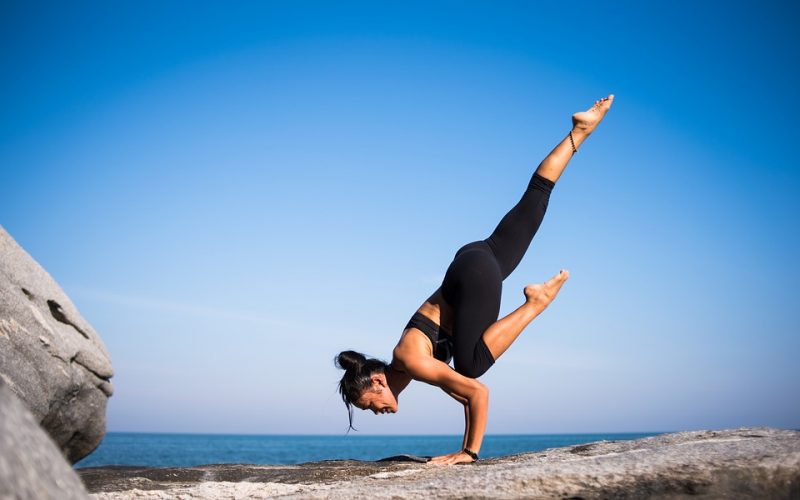Yoga is a physical and mental practice which consists of the body, mind, and spirit. The proceeding, that originated in India, is formulated to improve awareness, create a mind-body-spirit balance, cleanse, cure and strengthen the body, redeem the true self and, as practiced today, enhance fitness.
The most typical type practiced in the United States is hatha yoga, which consists of specific movements or postures (asana) and several breathing techniques (pranayama) and is often complimented with meditation (dhyana).
Yoga’s gentle, mindful and controlled movements can offer none or low-effect exercises for people in almost any physical condition. Yogic workouts and there are many which can calm tense muscles, boost flexibility and improve strength, balance, and vitality. Poses, breathing practices and meditation can also hike concentration, minimize stress and, among other therapeutic aids, pacify back pain.
Yoga: History
No one appears quite sure when yoga started, but it goes back thousands of years. Stone paintings in the Indus Valley portraying yoga positions date back 5,000-plus years.
Traditionally, yoga was a spiritual form, its aim being union with the absolute or the divine. The several workouts we relate with yoga were performed to draw up the body for long periods of meditation.
The word “yoga” refers to join or bind together and the practice joins together the body, mind, and spirit. On a spiritual level, it can mean to the union of the individual with the absolute truth or true self (Atman). It is often linked with Hinduism, but yoga outranks the religion. Hinduism has included components of yoga into its practices, as have other religions.
As it is generally exercised in the West, the focal point of yoga is more on the physical fitness contexts. Of course, it can be a spiritual endurance, if you opt to use it as such.
Yoga is now skilled around the world for its psychological, physical and spiritual aids. Americans have exercised it for more than 100 years, but it picked up fame in the 1960s as young people developed a taste for all things Eastern.
According to conclusions of a 2012 survey done by Sports Marketing Surveys USA on behalf of Yoga Journal, 20.4 million Americans, or 8.7 percent of U.S. adults, are supposed to practice yoga.
Yoga: Traditional Types
Here are some traditional types of yoga:
Raja:
It is also called the “royal road,” it focuses is mainly on meditation; it includes exercise and breathing practice with meditation and study.
Jnana:
It is named as the path of knowledge or wisdom, it is the path of yoga which utilizes the mind to get beyond the mind by asking questions such as, “Who am I?” “What is a reality?” and “What is permanent and unchanging?
Bhakti:
It is the path of love and devotion which focuses on devotion to and concentration on the guru or chosen deity and often includes chanting.
Karma:
In the yogic system of action and service, everything including the yoga postures is done with the mind intensified on the divine; activities are done selflessly for the greater good.
Tantra:
The path of ritual, it is based on the principle of consciously embracing the whole of life to unite with deity. It utilizes the energies of the body including sexual to transcend worldly attachments.
There also are various contemporary styles of yoga, most of which are a variety of yoga. All yoga styles look for the balance of body, mind, and spirit, but they may alter in how the asanas are done and in other ways, such as the focus on postures, alignment, the flow of movement or breathing. Some may be composed to suit special groups, such as pregnant women or older people, while others may utilize props or vary the temperature.
Yoga: Modern Styles
Some of the more popular modern yoga styles are as follows;
Ananda:
It emphasizes meditation through breath awareness, affirmations, and yoga postures. Its distinct feature is the utilization of affirmations while in the postures.
Anusara:
It means “following your heart” and respects each student’s capabilities and limitations. It includes the celebration of the heart, principles of alignment and balanced energetic actions in the performance of the postures.
Ashtanga:
Sometimes it is known in the United States as power yoga. It is a fast-paced, physically demanding series of postures designed to create heat and energy flow.
Bikram:
Sometimes it is known as hot yoga. This form consists of a series of 26 postures and two breathing exercises performed vigorously in a studio heated to 105 degrees with 40 percent humidity.
Forrest:
Intense long-held poses composed to develop skills in awakening the senses. It utilizes heat, deep breathing and vigorous sequences to sweat out toxins, while also concentrating on strengthening and centering your core.
Integral:
It focuses on the healing power of relaxation. This form indicates control of breath and meditation almost as much as the postures.
Iyengar:
It uses props such as straps, blankets, wooden blocks, and chairs to get postures which focus on symmetry and alignment. Poses are generally held longer than in most other yoga styles.
Jivamukti:
It uses vigorous poses in a flowing series while incorporating a variety of ancient and modern spiritual teachings. Its classes offer a “yoga education” with chanting, meditation, readings, music, and affirmations.
Kripalu:
It emphasizes proper breath, alignment, coordinating breath and movement and honoring the body’s wisdom. It is composed of three stages, the final one being surrendering to the body’s wisdom, by which time the student should be able to do the postures spontaneously and unconsciously.
Kundalini:
It is designed to awaken kundalini energy, which is stored at the base of the spine and is often depicted as a coiled snake. The emphasis is on chanting and breathing, rather than postures.
Sivananda:
It takes a gentle technique that consists of postures, chanting, meditation and deep relaxation in each session. Students are encouraged to lead a healthy lifestyle which includes a vegetarian diet.
TriYoga:
A systematic flowing yoga with a focus on the wave-like movement through the spine and on maintaining alignment through meditative transitions. Practices also include basics through advanced asana, pranayama and meditation techniques.
Viniyoga:
A gentle flowing form of yoga that focuses on coordinating breath with movement. It is often used with beginners and in therapeutic settings.
Vinyasa:
A general term referring to many styles of yoga which use a series of flowing postures combined with rhythmic breathing for an intense body-mind workout. It does not adhere to a specific sequence of poses but is generally based on a series of postures which together are known as sun salutations.
Is Yoga Right For You?
Yoga is both gentle enough and athletic enough to appease too many people. The beauty of yoga is that you do not have to be able to do all the positions; you can work within your own limitations and adapt your practice to your specific needs.
If you choose to try yoga, finding a teacher won’t be hard. Classes are available through recreation centers, senior centers, YMCAs, YWCAs, hospitals, health centers, community centers, meditation centers, and dedicated yoga studios. Many classes are relatively cheap they may even be free with your membership at a gym, community center, etc. And check your health plan; some insurance companies cover the charge of classes.
Inspect your regular health care professional for advice. He or she may know of a yoga class which meets your special needs. There are also resources on the Web for finding classes.
You can take individual lessons, too, but they will be more pricey. Whether you select to learn in a class or one-on-one, try to do so in person. Books, tapes, and DVDs thrive, but admirably, they should supplement what you learn from the class, and they can aid you as you establish your practice at home.
prior to your first class, consider sitting in on a session if this is allowed. Would you be cozy in the class with this teacher? Is the trot right for you? Make sure you find a class and teacher which feel right for you. If you have a certain medical condition, make sure the instructor has experience dealing with other folks in your situation. And once you find a teacher you like, be sure you tell him or her about any health issues.
Be advised, although, that there is no licensing concern to teach yoga, and many teachers may have done little more than complete a weekend training or correspondence course. If a yoga teacher is untrained, you may be at a greater risk of sustaining an injury in his or her class.
Yoga: Health Benefits
Yoga’s most obvious aids associated with stress reduction, flexibility, and relaxation. But as more studies are done, there is proof of other tangible health benefits. While it is no cure, yoga can be a beneficial help therapy for variations of conditions, such as cancer, heart disease, arthritis, asthma, diabetes, depression, fibromyalgia, and migraines. Even if you are in perfect health, you can aid from yoga. It enhances strength, flexibility, coordination, and range of motion. And since yoga builds up relaxation, boosts circulation and minimizes stress and anxiety, it also improves cardiovascular health and benefits the respiratory and nervous systems. Because it bolsters relaxation, yoga also aids sleep and digestion.
Yoga can make you more aware of your own body more conscious of its strengths, weaknesses, and requirement.
Medical experts are not exactly sure why yoga provides so many health aids, but more studies are underway. Some of its physiological impacts can be attributed to stress reduction and relaxation; since many health problems are provoked or aggravated by stress, stress-reduction can only help. And when you do yoga, chiefly meditation, and breathing exercises, you often breed what is known as the relaxation response, a stress-neutralizing physiological state which boasts a wide range of physical and mental benefits.
Yoga needs no special equipment or clothes, though a modest yoga mat may help offer cushion and grip. You can do the workout at home or at the office. If you have limited flexibility, you can even do them from a chair or bed.
Here is a look at how yoga can boost some specific conditions affecting women. As always, consult with your health care professional prior to beginning any new exercise program.
Arthritis and Fibromyalgia
Yoga may pacify the pain related to these conditions, and there are classes designed particularly for people with arthritis or fibromyalgia.
Few studies have been carried out, but anecdotal proof indicates that arthritis sufferers find relief from yoga.
For both arthritis and fibromyalgia, the stretching can temporarily calm stiff joints, improve flexibility and circulation and stimulate the release of endorphins.
The deep breathing and meditative aspects can aid you to deal with the stress of illness, especially something as frustrating as fibromyalgia.
Asthma
The breathing exercises which are an inseparable part of yoga seem to give some people an element of control over their breathing, hence minimizing the symptoms of asthma. It also strengthens the respiratory system.
Back pain
Yoga can offer temporary ease from back pain. It can also aid you to avoid certain kinds of back pain by making your back and abdominal muscles stronger.
Yoga stretches and strengthens back muscles; yoga and physical therapy utilize some similar movements. Some postures strengthen abdominal muscles, which aid to support the back.
Furthermore, through regular practice, yoga will aid you to learn to find potential trouble spots.
For example, you may be able to spot tense muscles and relax them before they become tight and sore. Alignment yoga can improve realign posture, reducing the chance of reinjury both in yoga classes and in daily life. It can also provide relief from nerve compression, which can cause back pain and sciatica.
Carpal Tunnel Syndrome
Research implies that yoga is an effective treatment for this repetitive stress injury.
One study, published in the Journal of the American Medical Association, said that carpal tunnel sufferer who regularly attended yoga classes faced less pain, greater flexibility and a stronger grip than those who used the usual treatment, a wrist splint.
Endometriosis
Yoga, like some other relaxation and meditative techniques, appears to offer some women with ease from the pain linked with endometriosis.
Chronic Pain
Yoga and other relaxation procedures have been shown to aid to minimize chronic pain. They are particularly effective for chronic headache and muscle tension.
Diabetes
Yoga is well suited for diabetics in that it enhances circulation and builds up a regular exercise regimen.
Heart/Coronary Artery Disease
Yoga promotes circulation and, as a stress-reducing or stress-management formula, it may play a role in hindering or reversing heart disease. Health care professionals often advice yoga or something similar for their heart patients.
High Blood Pressure
Evidence recommends that yoga decreases stress and improves relaxation, that may have a favorable impact on blood pressure rates. And there are studies advising that yoga may be effective in controlling hypertension, but more research required to be done.
Menopause
Yogic breathing procedures seem to aid some women to reduce hot flashes and other symptoms. And according to the American Yoga Association, some yogic exercises stimulate the glandular and reproductive systems, aiding balance body chemistry.
Insomnia
According to the National Institutes of Health, relaxation therapies and physical exercise, including yoga, can aid to alleviate insomnia.
Multiple Sclerosis
Yoga may aid women with MS to hike physical functioning. Some chapters of the National Multiple Sclerosis Society provide yoga classes and there are specialists in yoga for MS around the country.
Osteoporosis
Since yoga is a low-to-no-effect workout, some of the gentler postures may be appropriate even if you already have the condition; yoga may benefit lessen the pain linked with osteoporosis. Certain poses which position part of the body’s weight on the hands may also help in retaining bone density in the upper extremities and spine. Care must be taken, however, to stay away from excessive pressure or range of motion, such as a spinal extension. Each woman’s condition alters.
Premenstrual Syndrome and Menstrual Cramps
Yoga, when done regularly, can minimize symptoms of severe PMS, such as anxiety and depression in some women. Some postures can decrease pressure on the uterus, relieving cramps, and yoga’s gentle stretching can pacify stiffness and tension in the lower back.
According to the American Yoga Association, irritability, depression, and moodiness can be pacified by regular meditation, that is a part of many yogic practices. The association also describes that some yogic exercises stimulate the glandular and reproductive systems, helping balance body chemistry. And, of course, a regular exercise program of any sort aids lessen the severity of cramps for many women.
Pregnancy
Prenatal yoga classes are usually gentler than regular classes, and there is a greater emphasis on breathing and relaxation.
Mild-to-moderate workout during pregnancy is crucial for both you and your baby, and yoga’s gentle, relaxing movements may be ideal. And it can also help you deal better with the stress associated with pregnancy.
Prefer looking for a course devised for pregnant women, and talk to your health care professional before starting any exercise program. Some methods and teachers caution which women who are pregnant or breastfeeding focus on breathing and meditation exercises rather than the more strenuous yoga poses, especially cautioning against inverted poses for pregnant women.
Although, many serious yoga schools provide women’s classes with modified, supported poses which may bring strength, confidence, rest and relief to pregnant and nursing women.



